ISSN ONLINE(2319-8753)PRINT(2347-6710)
ISSN ONLINE(2319-8753)PRINT(2347-6710)
SushilB.Chopade1, Prof.K.M.Narkar2, Pratik K Satav3
|
| Related article at Pubmed, Scholar Google |
Visit for more related articles at International Journal of Innovative Research in Science, Engineering and Technology
In today’s scenario, the main weightage of investigation is to reduce the weight of product while upholding its strength. To solve problem in this regard composite materials play an important role. In this paper decreasing the weight of light vehicle is considered. The foremost component of the suspension system of vehicle is leaf spring, it has substantial amount of weight, and it is necessary itwould have ample strength because it needs to resist vibrations and jolts during its working. The prominence of the paper is to reduce the overall weight of suspension system and improve load carrying capacity of the leaf spring by using the composite material. The design considerations for this study are stress and deflection. The work also gives focus on the application of FEA concept to compare two materials for leaf spring and propose the one having higher strength to weight ratio. Two materials used for comparison are; conventional steel and composite E-Glass/Epoxy. In the present work deflection and bending stresses induced in the two leaf springs are compared The solid modelling of leaf spring is done in CATIA V5 and analysed using ANSYS 14.5.
Keywords |
| E-Glass/Epoxy, CATIA V5R20, Leaf Spring, ANSYS 14.5 |
INTRODUCTION |
| Suspension system of any vehicles contains leaf spring to absorb jolts. The vehicles must have a good suspension system that can deliver a good ride and goodhuman comfort. It is observed that the failure of steel leaf springs is usually catastrophic. [1]According to studies made for leaf spring the material with maximum strength and minimum modulus of elasticity in the longitudinal direction is the most suitable material. [2,6] In order to reduce the accidents, arising out of such failures conventional steel leaf spring can be replaced with gradually failing composite leaf springs. By doing this, the weight of the vehicle may also be reduced while maintaining the strength of the leaf spring. |
| A composite material is nothing but permutation of two materials that produce an effect so that the combination produces combined properties that are different from any of those of its constituents. This is done purposefully in today’s scenario to achieve different design, manufacturing as well as service advantages of product. In this paper leaf spring is representative of those products, for which automobile manufacturers are working to get best composite material that meets the current requirement of strength and weight reduction in one, to replace the existing steel leaf spring. [1] |
| The objective of the paper is to design leaf springs for deflection and bending stress made of steel and composite materials. The vehicle considered is four-wheeled light vehicle. Solid Modelling of leaf spring is done in CATIA V5R20 and analysis of the same is done by using ANSYS 14.5.Specific objective is to suggest suitable material for leaf spring among two stated above by comparing the analytical results with FEA results. The analysis of leaf spring is limited to static loading only. |
II. OBJECTIVE OF WORK |
| In order to safeguard natural resources and economize energy, weight reduction has been the main focus of automobile manufacturers in the present development.The introduction of better material, design optimization and better manufacturing processes can cause weight reduction in vehicle .The leaf spring is one of the potential items for weight reduction in automobile as it accounts for ten to twenty percent of the un-sprung weight. [2]Work in this paper has following objectives |
| 1) Static analysis of standard Steel leaf spring and composite E-glass/Epoxy leaf spring using FEA. Finding out the deflection and bending stress for the same. |
| 2) Comparison of the results of standard Steel leaf spring and composite leaf springs. |
| 3) Validation of results by theoretical calculations |
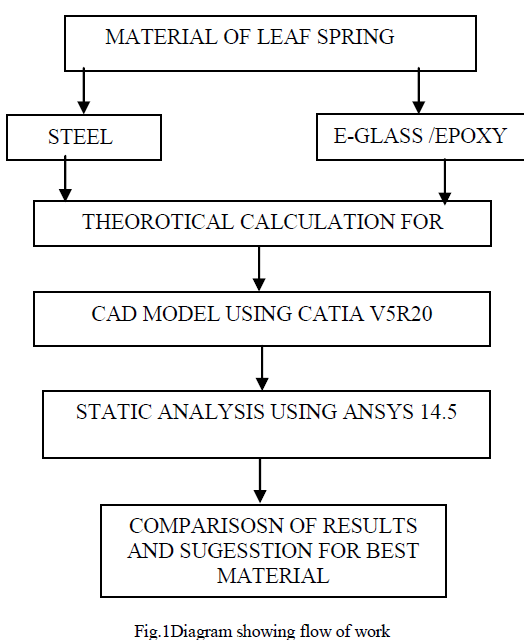 |
A. MATERIAL FOR CONVENTIONAL LEAF SPRING |
| The material used for conventional leaf spring is usually a plain carbon steel having 0.90 to 1.0% carbon. [2, 3] EN47 is suitable for oil hardening and tempering. When EN47 is hardened it offers excellent toughness and shock resistance which make it a suitable alloy spring steel for parts exposed to stress, shock and vibrations. |
B. FIBERS SELECTION FOR COMPOSITE SPRING |
| The commonly used fibers are carbon, glass, etc. The main advantage of glass fibers is low cost. It has high strength, high chemical resistance and good insulating properties. The disadvantages are low modulus of elasticity, poor adhesion to polymer, low fatigue strength and high density which increase spring weight and size. [3] The types of glass fibers are C-glass, S-glass and E-glass. The E-glass fiber is a high quality glass, which is used as standard reinforcement fiber for all the present systems well complying with mechanical property requirements. Thus, E-glass fiber was found appropriate for this application. |
C. ASSUMPTIONS [2] |
| 1. All Nonlinear effects are excluded |
| 2. The stress strain relationship for composite material is linear and elastic; hence hook’s law is applicable to composite material |
| 3. The leaf spring has uniform cross section |
C. SELECTION OF CROSS-SECTION |
| In the present work, only constant cross-section design method is selected. Since the cross-section, area is constant throughout the leaf spring, same quantity of reinforcement fiber and resin can be fed continuously during manufacturing. [1] |
III. DESIGN OF LEAF SPRING |
A. SPECIFIC DESIGN DATA |
| Here weight and measurements of four-wheeler model of “Ambassador BS IV” are taken. |
| Kerb weight of vehicle= 1150 Kg |
| Load Carrying capacity= 450 Kg |
| Gross weight of vehicle=1150+450=1600 kg |
| Taking factor of safety (FS) =1.15 |
| Acceleration due to gravity (g) =10 m/s2 |
| Hence, |
| Total weight (W) = 1600*10*1.15 =18400 N |
| Since the vehicle is 4-wheeler, a single leaf spring corresponding to one of the wheels takes up one fourth of the total weight |
| Therefore; F= 18400/4 |
| = 4600 N |
| The table I below shows the specifications of conventional leaf spring for selected vehicle; |
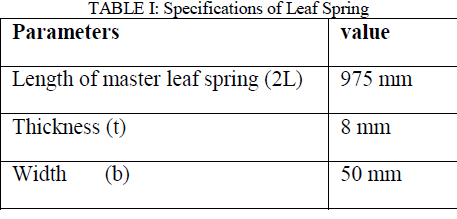 |
| The mechanical Properties of conventional steel are as shown in table II below; |
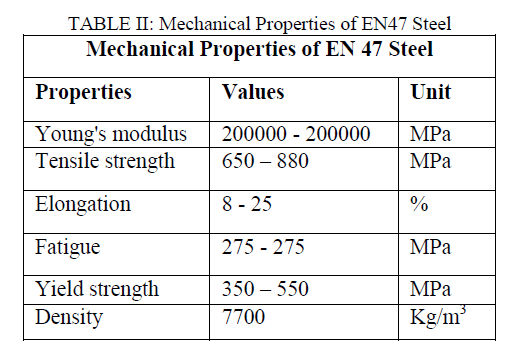 |
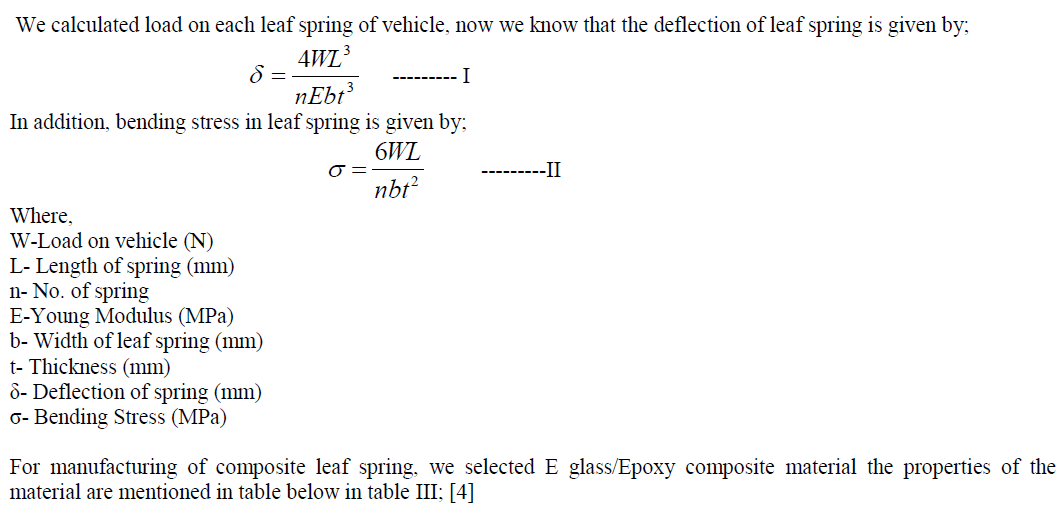 |
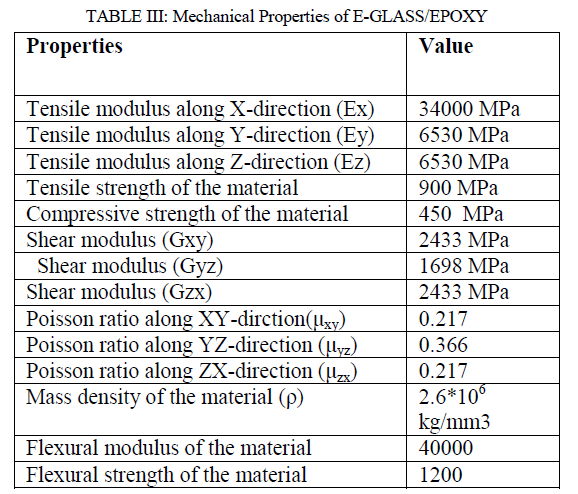 |
| With reference to equations I and II, the values of deflection and stress are calculated for conventional leaf spring and composite leaf spring for different values of load and these are as tabulated below in table IV; for composite material the values of young’s modulus and thickness of spring will be different. Rest all the values will be same as stated above .The values are, |
| E=34000 N/mm2 |
| t=35 mm |
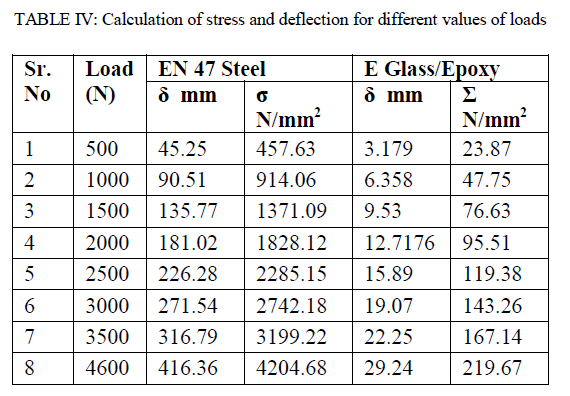 |
IV. FEA OF LEAF SPRING |
A. SOLID MODELING |
| In the present work, mono leaf springs of steel and composite materials are modelled. For modelling the steel spring, the dimensions of a conventional leaf spring of a lightweight commercial vehicle is chosen. Since the leaf spring is symmetrical about the neutral axis only half of the leaf spring is modelled by considering it as a cantilever beam and a load is applied on the leaf spring in z direction. [2]In the same manner discussed above composite leaf spring is modelled only thickness of leaf spring increases due to low modulus of elasticity. For Modelling of leaf, spring CATIA V5R20.is used. |
B. FEA USING ANSYS 14.5 |
| The solid model prepared in CATIA V5R20 is imported in workbench ANSYS 14.5 to perform static analysis for different load conditions. A stress-deflection analysis is per- formed using finite element analysis (FEA). The complete procedure of analysis is done using ANSYS-14.5. To conduct finite element analysis, the general process of FEA is divided into three main phases, |
| PRE-PROCESSOR: The pre-processor is a program that processes the input data to produce the output that is used as input to the subsequent phase (solution). [5] Fig 2(a) show the finite element model of leaf spring having material EN 47 steel where it was meshed by taking edge length as 8mm because of which a total of 31777 elements and 56965 nodes were created. |
| Method: tetrahedrons |
| Element Size: 3 mm |
| No of Elements formed: 31777 |
| No of Nodes created: 56965 |
| In the same manner discussed above the composite leaf spring is analyzed. As shown in fig. 2(b) |
| Element size: 3 mm |
| No. of elements formed: 52333 |
| SOLUTION:It is completely automatic phase. The element matrices are generated by FEA software. Nodal values and derivatives are computed and saved in data file. These files are further used by the subsequent phase (Postprocessor) to review and analyse the results through the graphic display and tabular listings. [5] |
| POSTPROCESSOR:The output consists of nodal values of the field variable and its derivatives. For example, in structural analysis, the output is nodal displacement and stress in the elements. The postprocessor processes the result data and displays them in graphical form to check or analyse the result. The graphical output gives the detailed information about the required result data. [5] |
 |
V. FEA RESULTS AND DISCUSSION |
| The FEA of the leaf spring of both the materials are carried out and obtained results for deformation and stress in the leaf spring for different loads. The fig 3.shows the results for deformation and von-mises stresses in both conventional and composite leaf springs. The results are for maximum load i.e 4600 N |
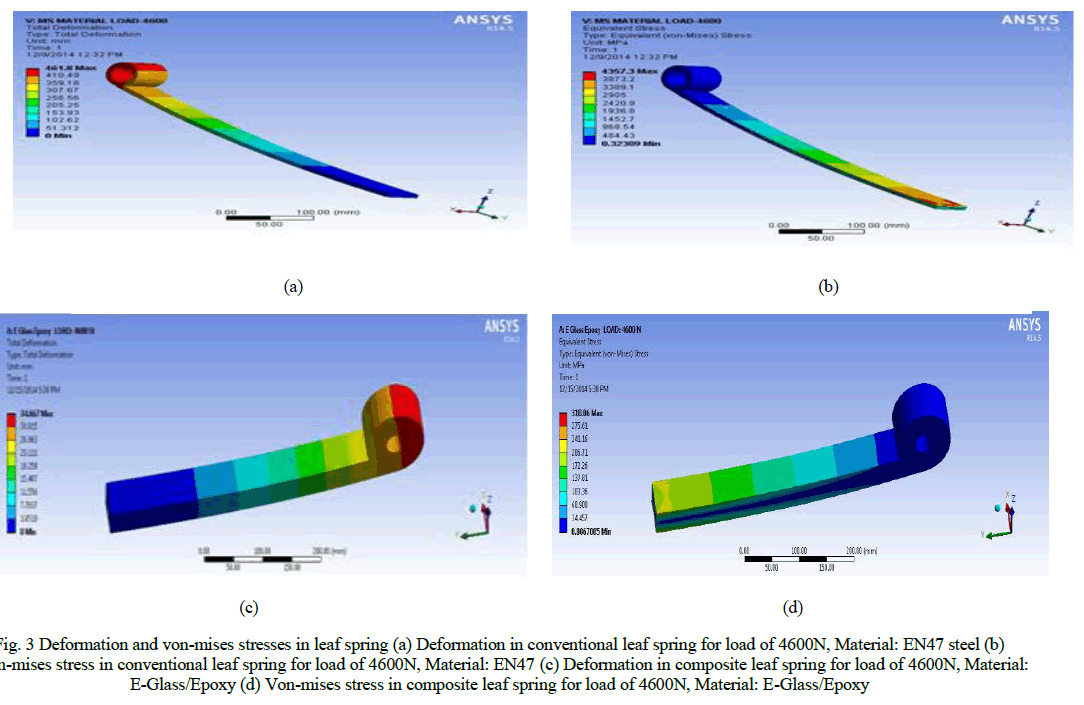 |
| The tabulated forms of results are shown in Table V below;if we compare the analytical results and FEA results of leaf spring of both the materials i.e. EN 47, and E Glass/ Epoxy Composite as described in Table IV and Table V. The percentage difference between the values of stress and deformation are in the range of 10% to 30%.Also we can say from Table IV and Table V that stresses in E- Glass /Epoxy composite material are less in both theoretical and FEA results as compared to EN 47. The graph In Fig 4 shows Variation of stresses for EN47 and E Glass/Epoxy composite material in both analytical and FEM way. |
| Also little consideration towards weight of the material, if we use composite material it reduces the weight of leaf spring. The table VI belowshows the percentage weight reduction in weight of materials. Reduction in weight is due to densities of materials. |
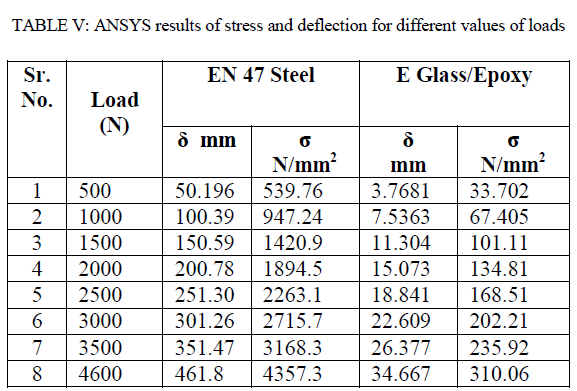 |
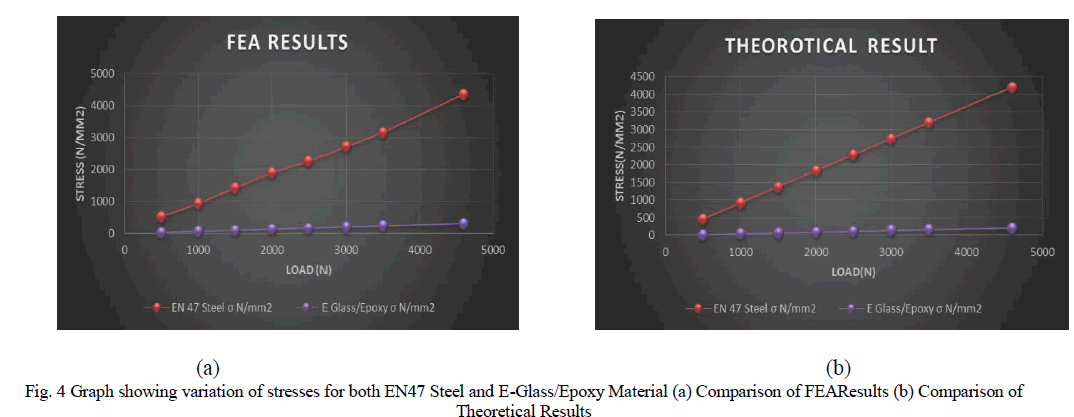 |
 |
VI. CONCLUSION |
| As automobile world demands research of reducing weight and increasing strength of products, composite material should be up to the mark of satisfying these demands. As leaf spring contributes considerable amount of weight to the vehicle and needs to be strong enough, a single E-Glass/Epoxy composite leaf spring is designed and analysed following the design rules of composite materials. In addition, it shows the comparative weight reduction of material between 30-40%. Also, the stresses produced in composite material are also less as compare to conventional steel material.The results obtained in theoretical and FEA solution are showing differences and hence it is recommended that the results should be verified with experimental work. This papers work is done for light four wheeler vehicles. The prototype of leaf spring not manufactured. One can research for dynamic loading of leaf spring made of composite material, as the work in this paper is totally based on static loading only. |
References |
|